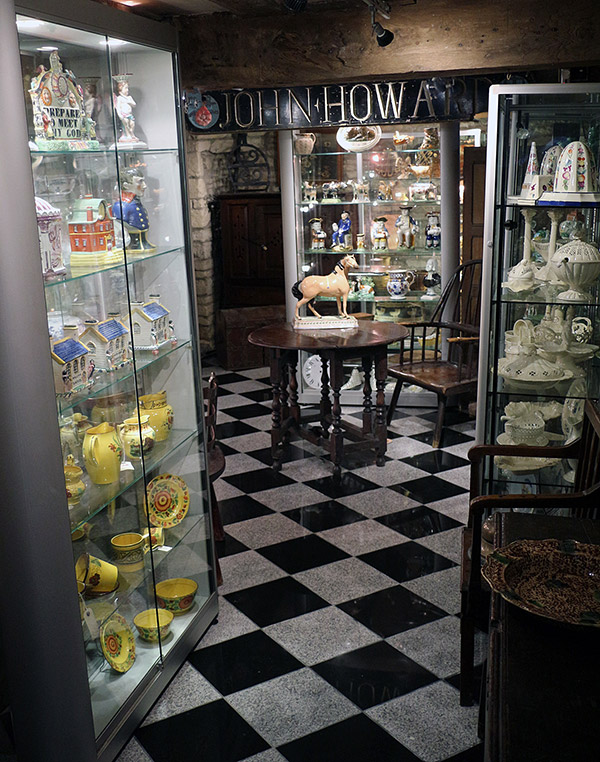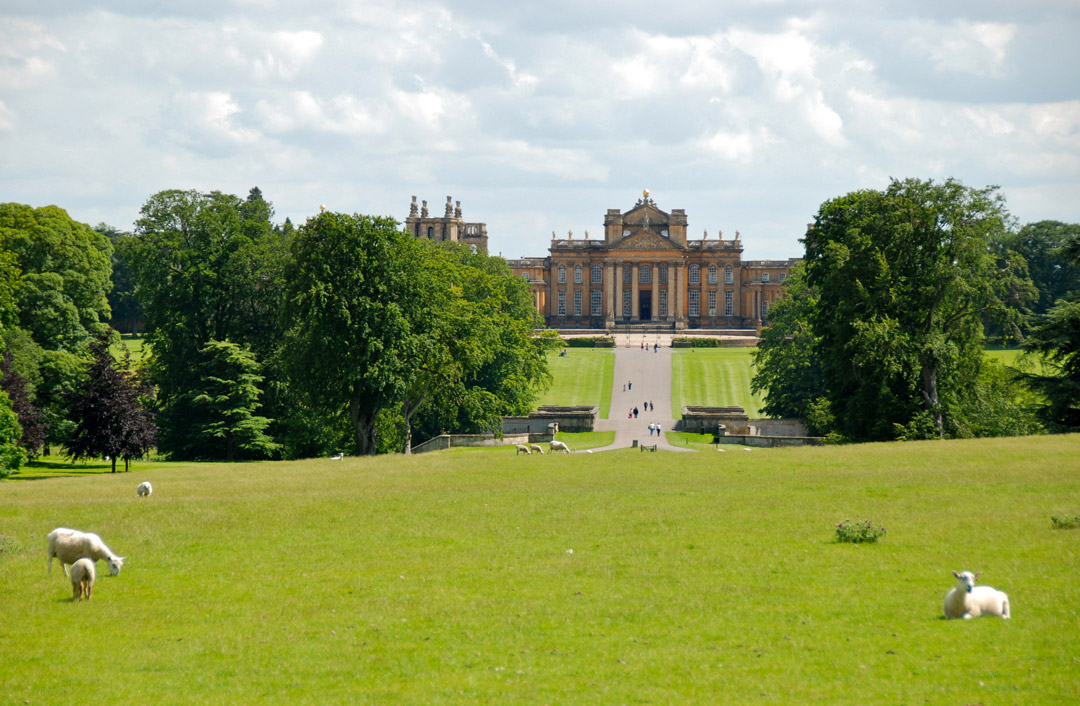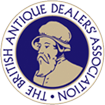John and Linda founded Howard’s of Aberystwyth in 1976 where they specialized in antique English, Welsh and Scottish pottery from the 18th and 19th centuries. Their policy is to supply the best examples possible of antique English, Welsh, and Scottish pottery. Represented in the inventory are early English cream bodied lead-glazed pottery, Staffordshire pearlware figures, Prattware, lusterware, English delftware, slipware, and quality examples from the UK of potteries from the 17th to early 19th century. Creamware, slipware earthenware, and early examples of Whieldon and Wedgwood feature strongly in the stock inventory.
View our 3D Virtual Showroom Tour

John is always looking for the piece with that “extra special something” and strives to select the best and often the rarest with a discerning eye based on 40 years knowledge and experience. The care and focus on the acquisition of inventory is a cornerstone of the business.
John is an internationally recognized authority on 18th and 19th century British pottery. He has been Chairman of the Ceramic vetting committee at the Olympia Fine Art, and Antique fairs in London for over 30 years and is a member of the Ceramic vetting team at the prestigious British Antique Dealers Association Fair (BADA) held in London.

In 2001 the antique pottery business was relocated to Woodstock near Oxford. Woodstock is only one hour from London and is an ideal base which to explore for antiques in the Cotswolds cities, town, and villages. The Cotswolds area boasts the largest concentration of quality art and antique dealers outside of London. John was Chairman for six years of the Cotswolds Antique and Art Association (CADA) the oldest and regional art and an association in the UK. With the move to Woodstock, the business name changed to John Howard at Heritage. Heritage is the oldest domestic dwelling in Woodstock built in 1495 and located in the center of the historic town, which is also the home of the World Heritage site of Blenheim Palace. A warm welcome awaits if you wish to visit, the showroom is open seven days a week 10am until 5pm and 1pm until 5pm on Sunday. A telephone call before your visit is advisable.
No longer exhibiting at antique fairs a strong online presence is maintained and they enjoy dealing from their impressive showroom in Woodstock. A large portion of their business is with the USA, for which there is a priority shipping service. John enjoys working with customers with their collections, interior decorators and Museums such as the British Museum London, The Metropolitan Museum New York, The Houston Museum Texas, Williamsburg Museum USA, The Geffrye Museum London, The National Portrait Gallery London and the Queensland Art Museum Brisbane Australia. For over 40 years, a strong bond of trust with customers has been nurtured, maintained, and reflected in the large portion of continuing transactions with long-standing returning clients.

All items sold are guaranteed for authenticity and backed up with a policy commitment to ensure complete customer satisfaction on all transactions. They are members of the British Antique Dealers Association and The CADA, which have codes of practice requiring a high quality of stock, and a depth of knowledge and integrity from member dealers.
John is pleased to have contact with collectors who may wish to sell individual pieces or an entire collection.
Fake and Reproduction of Early British Pottery
One of the most frequently asked questions asked is, “how can you tell if a piece is a fake or a later copy.” A very relevant question as there are indeed many pieces sold as antique which most definitely are not. Many of these reproduction pottery items are produced on a mass scale and usually sold with good intention by the manufacturer. However, these pieces, in the hands of the unwary or unscrupulous dealer are offered as the real thing to the unwary buyer.
Rare and valuable pieces have been faked for hundreds of years and made with the sole intention of deceiving the buyer. Such pieces rely on an experienced eye based on knowledge of continually handling and researching similar pieces to provide a valid opinion. Quite often the sensation of,” it just does not feel right” is enough to sound warning bells. The type of glaze, the weight of the piece, the texture of the body, specific characteristic details, such as size and embellishments associated with the type of ware or make, evidence of age and provenance are all part of a complex nuanced judgment.
The main advice is to buy from a reputable dealer who will guarantee the description and dating together with an invoice as proof of purchase. A good route to follow would be to deal with a Member of the British Antique Dealers Association who have strict code of conduct with an enviable reputation. All items acquired from John Howard are guaranteed genuine and given with a BADA headed invoice.
One of the most copied wares of English pottery are Staffordshire Figures. I have listed some features to consider when viewing:
- 19th century Staffordshire figures have a specific color palette.
- Many of the reproductions are made with a crude porcelain body.
- Extensive crazing often denotes a modern copy.
- Some blue blotches in the glaze is a good indicator that the piece is authentic.
- A chalking scratchy feeling at the rim of the base denotes modern copy.
- Is the weight exceptionally heavy or light if so doubt the piece.
- Many reproduction pieces are about 10% smaller than the originals.
- Slip casting relates to later figures.
- The mark “Made in England, Genuine Staffordshire and Ye Olde Staffordshire are all 20th century.
- Many reproduction figures manufactured in China are often decorated in an oriental fashion.
Myrna Schkolne has a very informative Youtube video which provides useful information on the subject of fakes and forgeries.
How To Buy
If you would like to buy an item which you have seen on one of our pages you need to check with us, either by e-mail, fax, phone of by completing the inquiry form, to ensure that the item is still available. If it is you can pay by one of the following methods:
- VISA or MASTERCARD
- USA dollar cheque (check)
- British Sterling cheque
- Bank money transfer. Details to be organised at the time.
We carry many hundreds of English pottery items so if you cannot find exactly what you are looking for please tell us, we may have it in stock. We also provide a finders service and may be able to help you find that special figure or piece.
Guarantees and Delivery
John Howard is a member of the British Antique Dealers Association (BADA), CINOA and the Cotsolds Antique and Art Dealers Association(CADA) and as such is committed to a very strict code of practice which assures clients the highest standard of professional conduct. Photographs are true untouched and fair representations of the actual items. Descriptions are detailed and accurate . In the unusual event that a purchased item has been incorrectly represented or a client is not completely satisfied, a full refund will be available provided we have been notified in writing/fax within fourteen days of purchase. We can wrap, pack and insure and we arrange for delivery in accordance with the clients wishes.
Recommended Reference Books Antique English Pottery
Listed below are some books from my library, which provide a tangible informative illustrated context to the scope of English, Scottish, and Welsh pottery from the 17th to 19th century.
- Staffordshire pottery Figures 1780-1840 by Myrna Schkolne Volumes 1,2,3,4.
- People, Passions, Pastimes and Pleasures Staffordshire Figures 1810-35 by Myrna Schkolne
- Prattware by John and Griselda Lewis
- The Leeds Pottery volumes 1 and 2 by John Griffin
- Creamware by Donald Towner
- 19th-century Lusterware by Michael Gibson
- English earthenware Figures by Pat Halfpenny
- Mocha and Related dipped wares by Jonathan Rickard
- London Delftware by Frank Britton
- English Delftware Pottery in the Ashmolean Museum Oxford by Anthony Ray
- Delftware in the Fitzwilliam Museum by Michael Archer.
- Delftware The tin-glazed earthenware of the British isles by Michael Archer.
- Dated English Delftware by Louis Lipski and Michael Archer
- The Longridge Collection of English Slipware and Delftware volumes 1 and 2
- English Delftware in the British Collection by Frank Britton.
- British Delft at Williamsburg by John C. Austin
- White Salt-glazed Stoneware of the British Isles by Edwards and Hampson
- English Slipware Dishes 1650-1850 by Ronald. G. Copper
- The Exhibition Catalogues of Jonathan Horne
- A Potted History Henry Willett’s Ceramic Chronicle of Britain by Stella Beddoe
- English Brown Stoneware 1670-1900 by Oswald, Hildyard, and Hughes
- Commemorative Pottery by John and Jennifer May.
- Nottingham Salt- Glazed Stoneware 1690-1800Henstock, Hildyard and Wood
- The Fishleys of Fremington a Devon Slipware tradition by John Edgeler
- English Slip decorated Earthenware at Wiilliamsburg by Leslie B. Grigsby


